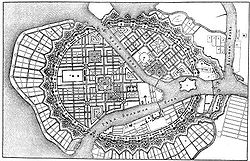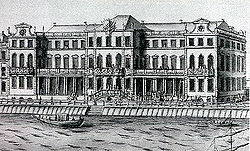
Jean-Baptiste Alexandre Le Blond
Encyclopedia

Saint Petersburg
Saint Petersburg is a city and a federal subject of Russia located on the Neva River at the head of the Gulf of Finland on the Baltic Sea...
in 1716.
Career in France
He was the son of Jean Le Blond, painter in ordinary to the king, a printseller on the Pont Saint-MichelPont Saint-Michel
Pont Saint-Michel is a bridge linking the Place Saint-Michel on the left bank of the river Seine to the Île de la Cité. It was named after the nearby chapel of Saint-Michel. It is near Sainte Chapelle and the Palais de Justice...
, Paris, and his wife, Jeanne d'Eu. He studied architecture with his mother's brother Jean Girard, in the service of Philippe I, duc d'Orléans. Jacques-François Blondel
Jacques-François Blondel
Jacques-François Blondel was a French architect. He was the grandson of François Blondel , whose course of architecture had appeared in four volumes in 1683 -Biography:...
implied that he had derived gardening expertise from André Le Nôtre
André Le Nôtre
André Le Nôtre was a French landscape architect and the principal gardener of King Louis XIV of France...
, finding that Le Blond was
- one of our Architects, who among us most knew how to profit from the precepts of the great MasterAndré Le NôtreAndré Le Nôtre was a French landscape architect and the principal gardener of King Louis XIV of France...
... It must be agreed, however, that, in imitating them, it would be suitable to be provided with a certain intelligence
Indeed, Le Blond was responsible for more than simply the engravings in Dezallier d'Argenville
Dezallier d'Argenville
The family of Dezallier d'Argenville produced two writers and connoisseurs in the course of the 18th century.Antoine-Joseph Dezallier d'Argenville , avocat to the Parlement de Paris and secretary to the king, was a connoisseur of gardening who laid out two for himself and his family, before writing...
's seminal work on the principles of French formal garden design, La théorie et la pratique du jardinage, 1709: according to the well-informed connoisseur Pierre-Jean Mariette
Pierre-Jean Mariette
Pierre-Jean Mariette was a collector of and dealer in old master prints, a renowned connoisseur, especially of prints and drawings, and a chronicler of the careers of French Italian and Flemish artists...
, chronicler of French artists, he laid out the structural "canvas" of the work and oversaw in detail its writing; the work was published anonymously, but in later editions Le Blond was credited with the text.
Named architecte du Roi, he made a set of presentation drawings, dated 1699, for the famous cascade and basin with its jet d'eau at royal Saint-Cloud
Saint-Cloud
Saint-Cloud is a commune in the western suburbs of Paris, France. It is located from the centre of Paris.Like other communes of the Hauts-de-Seine such as Marnes-la-Coquette, Neuilly-sur-Seine or Vaucresson, Saint-Cloud is one of the wealthiest cities in France, ranked 22nd out of the 36500 in...
constructed several hôtels particuliers in Paris, notably the hôtel de Clermont, rue de Varenne, and the hôtel de Vendôme, rue d'Enfer (today boulevard Saint-Michel).
As theoretician and illustrator of architecture, Le Blond produced the second (1710) and third (1720) editions of the Cours d'architecture de Vignole translated with commentary by Charles-Augustin d'Aviler, which Le Blond illustrated with his own drawings. These works introduced the distinctions between state apartments (appartements de parade) and private apartments (appartements de commodités) that would characterize French eighteenth-century planning, and he popularized the small chimneypieces that would take the place of the large ones in the Italian mode, popular in the previous century. He also provided illustrations for L’Histoire de l'abbaye de Saint-Denis (1706) by Michel Félibien.
Career in Russia


Saint Petersburg
Saint Petersburg is a city and a federal subject of Russia located on the Neva River at the head of the Gulf of Finland on the Baltic Sea...
, where he arrived in August. An unprecedented title of "Architect-General" was bestowed upon him, together with a pension of some 5,000 roubles. His position was superior to that of all other architects and builders working in St. Petersburg.
Within a short span of his stay there, Le Blond established the first nurseries along the banks of the Neva and about twenty workshops, specializing in carving, sculpture, stucco work, tapestries, and so forth. He also succeeded in introducing a program of illuminating the main streets with oil lanterns, designed by himself. The architect died suddenly of smallpox
Smallpox
Smallpox was an infectious disease unique to humans, caused by either of two virus variants, Variola major and Variola minor. The disease is also known by the Latin names Variola or Variola vera, which is a derivative of the Latin varius, meaning "spotted", or varus, meaning "pimple"...
in 1719. The tsar himself was present at the funeral, but Le Blond's grave at the St. Sampson cemetery has not survived.
Among his Russian projects, probably the best known is an idealistic plan which envisioned Vasilievsky Island
Vasilievsky Island
Vasilyevsky Island is an island in Saint Petersburg, Russia, bordered by the rivers Bolshaya Neva and Malaya Neva in the south and northeast, and by the Gulf of Finland in the west. Vasilyevsky Island is separated from Dekabristov Island by the Smolenka River...
as the focus of the new city. Le Blond's plan would have "enclosed the entire city within a perfectly elliptical wall of fortifications", with a network of streets at right angles and squares like the royal squares of France, but the project was not approved. Nor were his projects for the parterre
Parterre
A parterre is a formal garden construction on a level surface consisting of planting beds, edged in stone or tightly clipped hedging, and gravel paths arranged to form a pleasing, usually symmetrical pattern. Parterres need not have any flowers at all...
s of the Summer Garden
Summer Garden
The Summer Garden occupies an island between the Fontanka, Moika, and the Swan Canal in Saint Petersburg and shares its name with the adjacent Summer Palace of Peter the Great.-Original:...
and a residence for the tsar at Strelna
Strelna
Strelna is a municipal settlement in Petrodvortsovy District of the federal city of St. Petersburg, Russia, situated about halfway between St. Petersburg proper and Petergof and overlooking the shore of the Gulf of Finland...
(1717). Three centuries passed before Le Blond's design for a formal garden at Strelna was eventually implemented during the reconstruction of the Constantine Palace in 2003.
Le Blond's main building work in St. Petersburg was a palace of Count Apraksin. Although foreign visitors admitted that "even a king would have been jealous of such a noble dwelling," the palace was eventually demolished to make room for the Winter Palace
Winter Palace
The Winter Palace in Saint Petersburg, Russia, was, from 1732 to 1917, the official residence of the Russian monarchs. Situated between the Palace Embankment and the Palace Square, adjacent to the site of Peter the Great's original Winter Palace, the present and fourth Winter Palace was built and...
, which now occupies the site. Working with Friedrich Braunstein and Niccolo Michetti, the French architect also made many structural changes to the first palace and cascades of Peterhof (1717) for which none of his drawings survive, but which are known through copies made by J.E. Randahl, 1739.
Principal works of architecture
- Hôtel de VendômeHôtel de VendômeThe Hôtel de Vendôme was built as a private home in Paris; the famous Jean-Baptiste Alexandre Le Blond worked on the hôtel.The hôtel is the main relic of what once was the most popular convent in Paris, the Vauvert Charterhouse; founded by Saint-Louis and famous for its vineyard called the Clos de...
(Hôtel de Chaulnes, 1733 to 1758), rue d'Enfer, 1706–1707, for Antoine de La Porte, canon of Notre-Dame, backing onto the Jardin du LuxembourgJardin du LuxembourgThe Jardin du Luxembourg, or the Luxembourg Gardens, is the second largest public park in Paris The Jardin du Luxembourg, or the Luxembourg Gardens, is the second largest public park in Paris The Jardin du Luxembourg, or the Luxembourg Gardens, is the second largest public park in Paris (224,500 m²...
(today houseing the École nationale supérieure des mines de Paris). work also for Marie Anne de Bourbon - Reconstruction of the Hôtel de Duras, rue Saint-Augustin, 1708, for Louise-Madeleine de La Marck, widow of Henri de Durfort, duc de Duras.
- Hôtel de Clermont, 69 rue de Varenne, 1713, for Jeanne Thérèse Pélagie d'Albert de Luynes, marquise de Saissac
- House at Meudon, 1714, for Jeanne Baptiste d'Albert de LuynesJeanne Baptiste d'Albert de LuynesJeanne Baptiste d'Albert de Luynes, comtesse de Verrue was a French noblewoman and the mistress of Victor Amadeus II of Sardinia.-Biography:...
, comtesse de Verrue - Archbishop's Palace, AuchAuchAuch is a commune in southwestern France. Located in the region of Midi-Pyrénées, it is the capital of the Gers department. Auch is the historical capital of Gascony.-The Ausci:...
. - Jardins du Canet, near NarbonneNarbonneNarbonne is a commune in southern France in the Languedoc-Roussillon region. It lies from Paris in the Aude department, of which it is a sub-prefecture. Once a prosperous port, it is now located about from the shores of the Mediterranean Sea...
. - Maison Regnault at Châtillon-sous-Bagneux.
- Apraksin Palace, Saint-Petersburg, 1717-1718.
- Strelna and Peterhof parks, 1717-1718.
Further reading
- Olga Medvedkova, "Les architectes et les artistes français à Saint-Pétersbourg : présences et indirectes", and "Le plan général de Saint-Pétersbourg de Le Blond : vision utopique ou projet moderne?", in Trois cents ans de présence française à Saint-Pétersbourg, Les Français à Saint-Pétersbourg exhibition catalogue, Saint Petersburg 2003.
- Калязина Н.В., Калязин Е.А. Жан Леблон // Зодчие Санкт-Петербурга, XVIII век. SPb, 1997. Pages 67–111.

